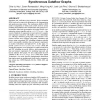334 search results - page 34 / 67 » Time representations and mathematical models for process sch... |
HPCC
2007
Springer
14 years 3 months ago
2007
Springer
Many optimization techniques have been adopted for efficient job scheduling in grid computing, such as: genetic algorithms, simulated annealing and stochastic methods. Such techni...
DAC
2006
ACM
14 years 10 months ago
2006
ACM
Simulation and verification using electronic design automation (EDA) tools are key steps in the design process for communication and signal processing systems. The synchronous dat...
ICAI
2003
13 years 10 months ago
2003
Reasoning about capabilities in multi-agent systems is crucial for many applications. There are two aspects of reasoning about the capabilities of an agent to achieve its goals. O...
WISEC
2009
ACM
14 years 3 months ago
2009
ACM
Time synchronization in highly distributed wireless systems like sensor and ad hoc networks is extremely important in order to maintain a consistent notion of time throughout the ...
MEMOCODE
2006
IEEE
14 years 3 months ago
2006
IEEE
The theory of latency-insensitive design (LID) was recently invented to cope with the time closure problem in otherwise synchronous circuits and programs. The idea is to allow the...




